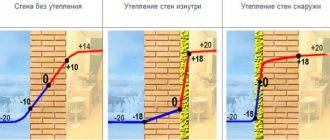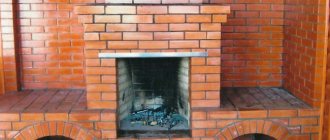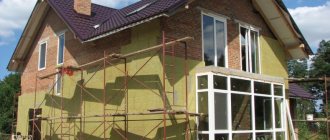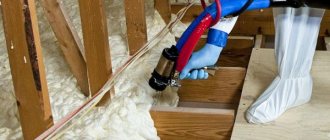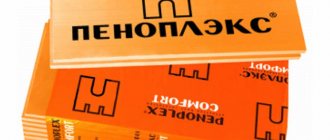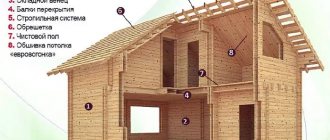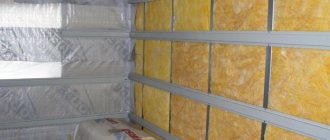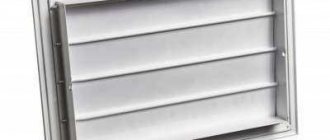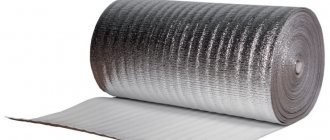Foil insulation is a specific thermal insulation material that not all professional builders know how to use correctly. The reason is trivial: they do not know at all or do not fully understand the principles of operation of foil insulation. What can we say in this case about home craftsmen who understand the essence of the issue even worse. As a result, you can see that the foil thermal insulation of the walls is carried out in accordance with all the rules and regulations of building science, but in the end it turns out to be meaningless from the standpoint of saving heat in the house. This is especially true for facade insulation.
The editors of the StroyGuru portal decided to take a closer look at the problems that arise when insulating walls with foil-coated thermal insulation materials and give specific recommendations to everyone when purchasing them.
Characteristics, pros and cons of foil insulation
Foil insulation is a combined material of 2 layers: a base, which can be polystyrene foam, extruded polystyrene, glass wool (basalt wool) and a reflective layer - aluminum foil. This insulation works on the principle of a mirror: it returns infrared (heat) rays back into the room, and the base insulation retains that part of the heat that has broken through the foil.
Therefore, foil insulation is always laid with a metallized layer towards the heat, i.e. premises.
The most important performance characteristics of insulation with foil
The foil applied to the insulation significantly changes the quality indicators of the base:
- Sudden changes in temperature and humidity are better tolerated;
- the vapor permeability threshold decreases, almost to zero value - 0.001 mg/m*K;
- the thermal insulation capabilities of the insulation increase - up to 97% of the heat is reflected back into the room;
- sound insulation abilities increase even for materials with conditional noise protection properties - up to 68%;
- the operational life of the foundation increases almost 2 times.
Pros and cons of foil insulation
Insulating walls with foil insulation has its advantages and disadvantages. Among the advantages we should highlight:
- increase in service life by 25-75% of the type of insulation on which the foil is applied;
- improving the level of thermal insulation;
- appearance (expanded polystyrene) or improvement (basalt wool) of noise protection properties;
- reducing the thickness of the insulation, which leads to a reduction in mechanical loads on the building structure, and also preserves usable space in the house;
- more efficient heat conservation, which, firstly, saves the family budget, and secondly, reduces the load on heating systems installed in private homes. And this, in turn, extends their resource;
- absence of drafts in rooms insulated with heat insulators and foil;
- simple installation - you can insulate the walls yourself;
- moisture resistance - there are no restrictions on use in rooms with high humidity, for example, a bathhouse.
Important: in almost all materials in which foil insulation is considered, one of the main advantages is considered to be low price, which is an incorrect approach to analyzing the strengths and weaknesses of this thermal insulator. After all, there is such a range of prices on sale that it is better not to touch the price factor. It can be both a plus and a minus.
Among the disadvantages, first of all, you need to pay attention to the following points:
- no screed is poured onto foil insulation - the point of using foil for insulation is lost: it simply does not work;
- thin insulation with foil does not provide complete protection against heat loss. It is necessary to pair other thermal insulators with such material;
- to glue the butt seams, you need to buy a special, metalized adhesive tape, which increases the estimated cost of repairs (construction);
- It is undesirable to fasten insulation with foil with nails and dowels - the integrity of the foil layer is compromised, as a result of which the thermal insulation properties of the material decrease.
Price
in the production of foil insulation on the Russian market :
- Jermaflex;
- Izolon;
- Penofol;
- Tepofol;
- Folgoizol;
- Ecofol.
| Firm | Characteristics | Price |
| Jermaflex | 1.2 m x 8 mm | 80 RUR/m² |
| Izolon | Type A, thickness from 2 to 10 mm, length 1 m | 140-260 RUR/m² |
| Penofol | Type A, thickness from 3 to 20 mm, length 36-12 m (the thicker, the shorter the meter) | 53-278 RUR/roll |
| Tepofol | Type A, thickness from 2 to 10 mm, length 2.5 m | 40-1200 RUR/roll |
| Folgoizol | Type A, thickness 10 mm, length 15 m | 1650 RUR/roll |
| Ecofol | Type A, thickness from 2 to 15 mm, length 25-10 m | 780-1030 RUR/roll |
Which foil insulation is best for walls?
Different operating conditions of insulation indoors and outdoors dictate their own requirements for insulation, including those with an applied layer of foil.
Inside
In principle, any foil insulation can be used to insulate walls. Even if income allows, a foil stopper. But the practice has introduced its own specialization: for walls, foam plastic and mineral wool, for warm floors, cork and extruded polystyrene.
For thermal insulation of walls in residential premises, foiled polystyrene foam and cotton wool have no advantage over each other either in the ability to retain heat or in the simplicity of technology. Here the price factor comes first, and in some cases durability. In this regard, we note that basalt wool has a longer service life than foam plastic and glass wool.
But in rooms with high temperature and humidity, such as a steam room in a bathhouse or a sauna, foil basalt wool is needed. Glass wool is afraid of humidity, and polystyrene foam is afraid of high temperatures. At the dacha, you should avoid using polystyrene foam and mineral wool because of mice and rats.
Outside
The use of foil insulation to protect the facade from heat loss is inherently meaningless. To explain what has been said, abstruse reasoning is needed about the nature of infrared rays, their length, ability to be reflected, etc. and so on.
Let's get away from all this and use a few simple examples to show that in cold weather the reverse process occurs: the cold is transmitted inside the insulation.
1. The work of foil in reflecting heat is completely identical to the work of a mirror. In bright sunlight, the reflected bunny is very bright and clearly visible. On a cloudy day, the reflected rays will form a faint spot. At night there is no reflection of light to speak of.
Foil works the same way. The higher the thermal energy flux, the more efficiently the polished surface of a thin layer of aluminum works, reflecting a large flux of thermal radiation. This example already shows that at subzero temperatures the foil simply has nothing to reflect - the number of infrared rays is low, and they have a long length, which, by the way, is also important (long waves easily overcome a thin layer of foil).
2. Let's carry out a simple experiment. On a sunny day, place a mirror, a sheet of construction foil for wall insulation, and a piece of any metal nearby, facing the sun.
After 3-4 hours, we touch our hand alternately to the mirror (you feel cool), the foil (warm), and the metal (you can get burned). And then we will carry out the same operation in severe frost. Let’s touch again (those who are very curious can do this with their tongue) to the materials one by one. They are all equally cold. Or did someone hope that aluminum would be warm?
Let's summarize: in cold weather, the foil cools down to the same temperature that it stays outside. Glued to the insulation, it intensively relays the cold to the substrate (insulation). The result is insulation in reverse: the foil layer does not protect, but rather reduces the thermal insulation properties of the insulation on the facade.
Life time
Since foil insulation appeared relatively recently, it is not yet possible to determine the exact expiration date. However, after conducting experiments, we can say that the material does not lose its properties for 200 years.
The service life of the installed insulation depends on the adhesive used. If the adhesive composition has passed its expiration date, then you can re-install it with the same heat insulator.
There are a lot of insulation materials on the construction market. The choice is so wide that the question arises, which is better. To answer, you need to compare the characteristics of the thermal insulation material and the scope of application - street, living room, garage or agricultural building.
Required materials and tools
There are several types of foil materials in the retail chain. Their installation requires different materials and tools. Therefore, we provide a complete list of the required set of tools, specifying when and where they will be needed.
Materials you will need:
- foil insulation;
- wooden beam 50x50 mm for lathing;
- spacer bar (20x50 mm) for installing a counter-lattice;
- plasterboard or OSB for covering the frame;
- primer;
- adhesive for insulation - individually for a specific type of substrate (“CERESIT CT 190” for basalt wool, “CERESIT CT 85” for foam plastic);
- metal corners, self-tapping dowels for the wall and wood screws - fasteners for assembling the sheathing.
The tools you should have on hand are:
- homemade sawhorses or stepladder (you can use a strong table);
- a hammer drill or electric drill - will be required when attaching the sheathing trim to the wall;
- screwdriver;
- mixer attachment for stirring glue;
- glue container;
- wood hacksaw;
- construction knife with replaceable blades;
- putty knife;
- level;
- roulette.
What kind of glue to glue foamed polyethylene with?
When choosing insulation, a special place is occupied by foamed polyethylene - a material with sound, heat and vapor barrier properties. Depending on the manufacturer, it can be penofol, isolon or polyfoam. The construction market offers different types: with one-sided or double-sided foil, as well as with a self-adhesive plane. The material on which the insulation is attached also varies. Based on all the parameters, you need to be able to choose the appropriate adhesive for polyethylene foam.
Preparatory work
Before we consider the technology for preparing walls for insulation, we note that we will only consider internal work, since foil thermal insulation for external walls is essentially money thrown away in the cold, as mentioned above.
The presence of a layer of foil on the insulation eliminates the “wet” method of insulation for several reasons:
- additional fastening of the slabs with dowels is necessary, which destroys the integrity of the metallized layer, reducing the effectiveness of thermal protection;
- decorative plaster will not adhere to foil;
- when the outer layer of the reflector is in close contact with any other materials, the effect of reflecting infrared rays disappears: the material in contact with the foil will heat up, in turn heating the aluminum, and it, along the chain, will transfer heat out into its substrate, and not into the room. That is why the instructions for using foil materials for insulation provide for the installation of a ventilation gap. In this case, the reflected heat rays will heat the skin. In this case, the foil itself does not heat up much.
Since there is no “wet” method of thermal insulation, then there will be lathing. This is where all the preparatory work is geared towards. Necessary:
- remove from the wall everything unnecessary that interferes with work: switches, sockets, lamps, various fasteners, etc.;
- remove old finishes and, if necessary, plaster;
- clean the surface from dust, dirt, soot and grease stains;
- repair small and large cracks;
- prime the wall in two passes.
There is no need to carefully level the surface - the insulation will hide everything.
In more detail, the process of performing the above operations can be found in the article “How to prepare walls for wallpapering.”
After the primer has dried, you can begin installing the sheathing. Detailed instructions for this stage of work are presented in the material “Wall insulation with stone wool”.
Attention: window and door openings are covered with battens under mineral wool. This is not done under foam plastic. However, in the case of foil foam, the openings will also have to be padded, because... Great difficulties arise when strengthening the ends and outer corners of polystyrene foam.
Let us briefly list the main stages of the sheathing installation:
- vertical trim posts are adjusted to the height of the ceiling and attached to the wall;
- horizontal strapping is screwed to the fixed racks using metal corners;
- Vertical internal slats are installed. The pitch is equal to the width of the insulation sheets;
- horizontal slats are installed. They are only needed under drywall. Vertical posts are sufficient for OSB boards.
Briefly about the main thing
Reflective insulation works according to a special principle based on a layer structure. The main layer consists of a porous or fibrous material; on top (sometimes on both sides) it is complemented by a layer of aluminum foil or metallized film.
It is the shiny surface that does the main job of retaining heat in the room. Additionally, it serves as a steam, hydro and sound insulator, and if the installation technology is violated, it causes the appearance of a thermos effect.
Common foil materials include polyethylene foam, basalt and glass wool, and foil polystyrene foam. To fix the material on the surface, you need a stapler or dowels; the joints are fixed with aluminum adhesive tape.
Insulation technology
For work on insulating walls indoors and facades made of foil insulation, the same instructions apply. However, there are nuances that we will talk about.
Inside
Foil for insulating walls from the inside of a house with different substrates is attached to the sheathing using almost the same technology, but with adjustments for the type of insulation base.
Styrofoam. Polystyrene foam can be with or without a pre-applied adhesive layer on the back side. In both cases, the slabs are cut to size for the cells. The protective film is removed from the insulation with glue, after which it is pressed against the wall surface and held in this position until the adhesive composition begins to polymerize (the time is always indicated on the packaging or on special inserts).
To fix the foam without glue, you need to perform a little more operations:
- dilute the glue, strictly following the instructions on the package. Stir with a mixer until you get a homogeneous mass without lumps;
- give the glue time to mature. Minimum - 5 minutes;
- apply glue to the back of the polystyrene foam;
Important: polystyrene foam is the only type of insulation that has secrets when applying glue. All the nuances of a seemingly simple operation are in the article “Wall insulation with foam plastic.”
- insert the plate into the cell, then fix it with glue;
- all gaps and cracks are filled with mounting foam or polyurethane adhesive foam;
It is extremely important: when using polyurethane foam, you must check how the foam reacts to it. Many brands melt polystyrene foam with their own solvent.
- after completing the insulation work, fill the counter-lattice;
Attention: vapor barrier work is not carried out: the foil itself serves as an excellent vapor barrier.
- sheathing is installed.
Glass wool. It is attached with glue using the same technology as polystyrene foam. But there is a nuance here. Each roll of glass wool is rolled out one day before the start of work and remains in this position until cutting to size begins.
Basalt wool. Unlike previous materials, basalt wool is cut larger than the sheathing cells and inserted into them at random. It's enough.
The sheathing is also laid on top of the mineral wool, and the sheathing is mounted on it.
In cool steam rooms and saunas, a frameless insulation system is used on the walls. Basalt wool is glued to the wall, the seams are closed with a special tape... and that’s it. No finishing work.
If children use the sauna, there is a risk of getting burned. Then vertical frame posts are attached to the wall, basalt wool is glued, the main part of the sheathing is mounted, and finishing work is carried out.
Outside
Man is designed in such a way that he likes to learn not from others, but from his own mistakes. For those who belong to their number and still want to use foil material for external insulation (by the way, there are many of them, which is confirmed by numerous photos on the Internet), we refer you to the works on our website: “Insulation of walls with foam plastic” and “Insulation of stone walls cotton wool”, where the processes of facade insulation are described in detail. All operations are performed absolutely accurately, without any changes or exceptions.
Still, it’s better to learn from other people’s mistakes. By the way, a question for the owner: how will he apply decorative plaster? Judging by the photo, the façade was prepared specifically for it.
Manufacturers: list of verified brands
Penofol can be glued to concrete using different compounds; there are several manufacturers on the market offering proven substances.
The best options for compositions for gluing penofol to concrete:
- Weicon Easy-Mix PE-PP 45
– two-component adhesive that provides high quality fixation. The base is methyl acrylate.
- Moment
– two-component sealant, prepared from two substances according to the instructions, must be used within the specified time.
- Tilit
– Suitable for joining seams, but can also be used for gluing sheets.
- Titanium
– easy to use, lightweight composition, exhibits high adhesion to concrete, one-component, glues foil penofol well.
- Ceresit (CT83)
– universal composition for all types of surfaces.
- Atlas Stopter K-20 glue
– exhibits high technical characteristics and ensures high-quality connection.
- Allfix
– the composition is universal, suitable for all types of bases, provides a high level of adhesion.
- Facade
– one-component composition, frost-resistant and waterproof, suitable for outdoor work.
- Luxe-88
– three-component adhesive, antibacterial and absolutely safe, provides instant adhesion.
- T-Avangard-K
– not only glues, but also provides additional waterproofing.
NPE - “bullshit”?
But this time I was disappointed. Manufacturers of polyethylene foam unanimously repeat in unison - there will be foil polyethylene foam in heated floor systems! This miracle material almost completely insulates the downward flow of heat. On the other hand, there are a large number of forums where the need to use this material is questioned. People's arguments are:
1. The thermal conductivity of polyethylene foam is comparable to the thermal conductivity of polystyrene foam. Technical calculations show that in order to effectively block the transfer of heat down through the floor slab, it is necessary to use at least a 30 mm layer of foam. What's the point of using a 3 or 5 mm layer of polyethylene foam? This is a negligible thickness and will do absolutely nothing.
2. In the screed, polyethylene foam (actually polyethylene with air bubbles) will shrink to 1 mm and stop working .
3. Foil reflects IR (infrared) radiation, but not inside a solid body. The statement that foil works as a reflector in a heated floor system is untrue and is simply nonsense. In addition, aluminum foil is corroded with a bang by the alkaline environment of the setting screed, and all kinds of metallized lavsan films that look like “aluminum foil”, although not corroded by the screed, are complete “bullshit” in terms of reflecting IR radiation .
These are the opinions you can find on the forum pages. Well, it seems quite convincing. But the opinion of forum authorities is one thing, but the research conducted is completely different. Unfortunately, I have not found information anywhere on the Internet about the effectiveness of using foiled polyethylene foam in TP systems. That’s why I was tormented by vague doubts, especially against the backdrop of messages like “I made it without a backing and it doesn’t heat, but my neighbor made it with a backing and it warms.” I didn’t want to make decisions based on old wives’ tales, so I decided to conduct my own experiment to reliably find out whether there should be polyethylene foam in the screed or not.
Is polyethylene foam effective as a thermal insulator substrate in a Warm Floor system?
And now I turn, in fact, to the actual study of the use of polyethylene foam as a heat insulator and substrate for pipes and underfloor heating cables. As I said above, it is not always possible to increase the thickness of the screed using expanded polystyrene. Often only 3-5 mm are left for insulation. And then foil polyethylene foam comes into play.
In my basement, I used extruded polystyrene foam from Techno-Nikol, since the ground below is cold. But when installing a heated floor between the first and second floors, I seriously thought about it. By and large, completely cutting off the downward flow of heat in my case was not at all necessary. After all, the ground floor is residential and heated. In addition, a 30 mm layer of polystyrene foam with installation on my area cost about 26,000 rubles. So I decided not to use foam. Having a warm ceiling in your own heated basement is not at all superfluous. But should you use a polyethylene foam backing? The costs are significantly lower, but they exist nonetheless. Is this a waste of money or does a thin layer of polyethylene foam insulate the downward heat flow to some extent. All heating in my house is automated and divided into zones and circuits with individual regulation. From an automation point of view, this means that it is better to minimize the influence of underfloor heating on the ground floor on the heating of the basement, since the nature of the heating is different. For example, in the basement, due to the large inertia of the soil, the heating is always turned on last in the fall. An acute question arose whether to spend 5-6 thousand on several rolls of polyethylene foam for TP or not. Does it work or not? In such cases, I often resort to the help of the Internet...
Types of penofol
There are 5 categories of penofol sold on the modern market:
- Type A is covered with foil on one side only. Used as additional insulation or waterproofing layer in residential buildings. In technical rooms it can be used as the main insulation, but for a private house its “capacity” is not enough.
- Type B is covered with foil on both sides. This is the best choice for insulating an apartment or wooden house from the inside with penofol. Other heat insulators are not needed - the characteristics of penofol are quite sufficient for complete protection.
- Type C is identical to Category A, but is self-adhesive. One side is lined with foil, and the other is coated with water-repellent and heat-resistant adhesive. It costs a little more, but its ease of installation speaks in its favor.
- Type R is similar to A, but the foil has a raised texture. It is used in professional construction, but for domestic use it is less suitable than other categories.
- The ALP type differs in that the foil is laminated. It can be one-sided or two-sided. Mainly used in the installation of heated floors.
Penofol used in a wooden house must belong to categories B (for basic insulation), as well as A or C (for additional insulation).
